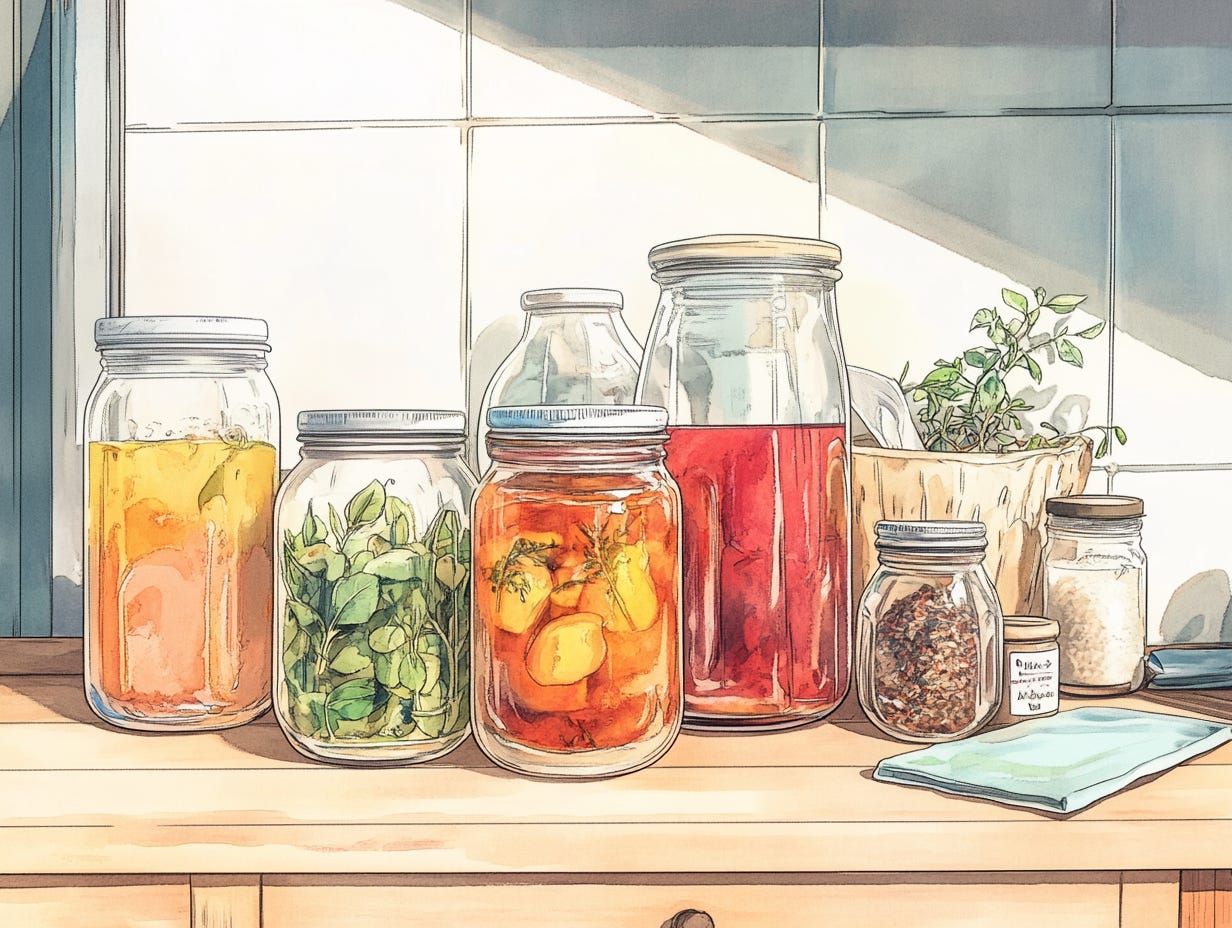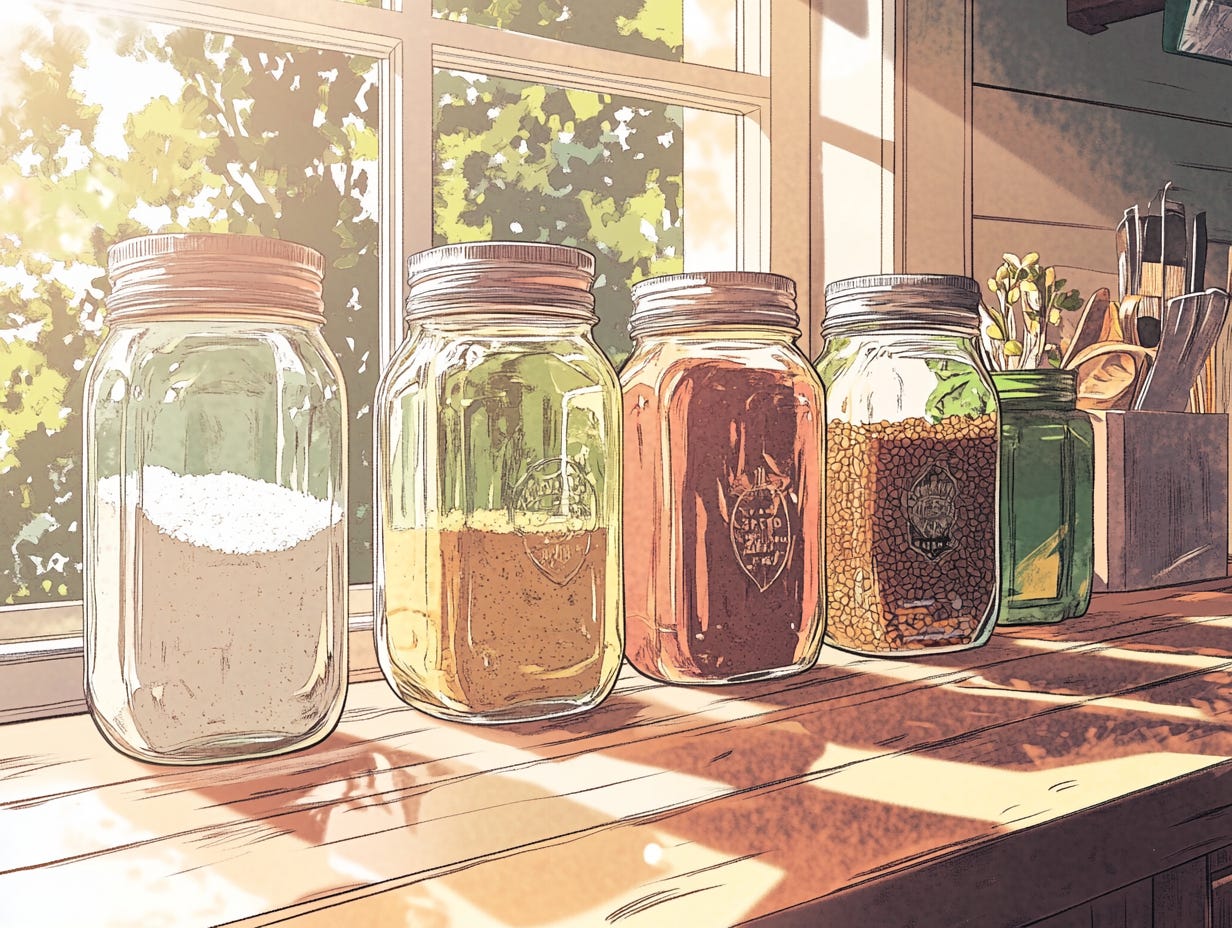The Best Budget Non-Toxic Glass Food Storage Containers That Are 100% Plastic-Free
How to Build an Affordable Non-Toxic Kitchen Storage System for Under $20 (or Free!)
If you've ever stored broth or pasta sauce in plastic containers, you've probably noticed how different they taste compared to when they were fresh-made or from a newly opened glass jar. But it's not just about taste. Plastic—especially recycled plastic—can leach endocrine disruptors and toxins into your leftover meals, particularly when used with acidic or hot foods. That "off" leftovers taste you're accustomed to may have nothing to do with the food going bad! The good news? One simple and very inexpensive kitchen swap can keep your food and family safer. Here's how to switch to glass for pennies per meal.
The Clear Gold Standard for Non-Toxic Storage
Besides being beautiful and letting you easily see what's inside, glass containers are chemically inert. That means:
No Leaching, Ever. Unlike plastic containers—which can release harmful chemicals (BPA, phthalates, microplastics) when they heat up or age—glass won’t interact with your food. You can store hot bone broth, cold cuts, or even acidic tomato sauce without worrying about invisible contaminants seeping in.
Flavor and Nutrient Integrity. Because glass doesn’t absorb odors or flavors, your meals taste just as you intended. Your next-day steak won’t pick up a “plastic” aftertaste; your homemade broth won’t take on lingering notes of last week’s soup.
Safety and Purity. When tiny fingers clam up on a glass cup, there’s no chemical trade-off. You’re giving them a toxin-free vessel, and giving yourself peace of mind too.
Got a pantry full of plastic? Making the healthy swap to glass might be more affordable than you think! Here are some low to no-cost ideas for going plastic-free.
Mason Jar: The Low-Cost Everyday Workhorse
If there’s a poster child for glass food storage, it’s the classic Mason Jar. They can be easily bought online for less than a dollar a jar, or if you're willing to do a little hunting, at local stores for less than that. Here are some ways to use them to quit plastic:
Leftovers and Meal Prep
Bone Broth & Stock: Pour hot broth straight into a wide-mouth quart (32 oz) jar; seal and freeze. Defrost in the fridge and heat in a saucepan or the microwave.
Dinner in Two Minutes: Batch prep meals and spoon them into wide-mouth pint (16 oz) jar. Reheat in the microwave or oven, and tip it out onto your dinnerware (or eat it out of the jar and you'll cut down exponentially on doing dishes!).
Baby Food & Toddler Drinks
Meat Purees: When I started making pureed salmon and beef for my then six-month-old, I used the 4 oz jelly jars to store and feed. Baby gets a great view of his food and no plastic leaching into it.
Mason Bottle Straw Tops: This platinum medical-grade silicone straw top is a staple in our house. I put it on an 8 oz regular mouth jar (which hasn't broken yet, despite being dropped from table height–twice! But if you don't want to give you toddler glass, they also have a stainless steel jar).
Beverages & Hydration
Water, Iced Coffee, Bone Broth Sippers: Use a lid with a straw hole on a wide-mouth pint, quart jar, or stackable drinking glass for splash-proof hydration. Skip plastic completely with a Made in USA glass straw.
Infused Water: Drop in a sprig of rosemary or a few berries into a half-gallon (64 oz) jar, fill with water, and let it steep in the fridge. No plastic floating around.
Pantry Storage
Dry Goods: For items like coffee, salt, or spices, Mason Jars keep everything visible, organized, and airtight.
I love these one-piece stainless steel lids for everything–from storing pantry goods to refrigerating leftovers to freezing baby food.
Repurposed Jars: A Zero-Cost Solution
If you’re already enjoying spaghetti sauce, jam, salsa, or pickles from the grocery store, you’re halfway to a plastic-free pantry—all those glass jars can be reborn as your new favorite storage vessels. My own “aha” moment came when I realized how many jars I tossed out each month. Instead of letting them accumulate in the recycling bin, I started setting them aside, washing them, and peeling off labels. Now I have a ready supply of 8 oz to 32 oz jars—without ever spending a dime.
Here’s how I give preloved jars a second life:
Clean & De-label
Many labels can be pulled right off the dry jar. Start at a corner and go slowly, as this helps to keep the adhesive attached to the label instead of the jar.
For labels that are a bit more stubborn, soak the jar in warm, soapy water for 15–20 minutes. Then rub off the paper label and use a scrub pad or a dab of olive oil to remove stuck on glue.
Match Lids & Repurpose
Save original lids whenever possible—many screw-tops seal airtight even after multiple uses.
For lids that are rusty or can't be reused, repurpose these as open-jar storage for things like extra utensils, glass straws, or keeping writing utensils within arm's reach.
Sort by Size & Function
Keep a “Prep Station” shelf in your kitchen where 4 oz and 8 oz jars live—perfect for small meat purees, condiments, or toddler snacks.
Use 16 oz and 32 oz jars for batch-cooked bone broth, shredded beef, or diced chicken. These sizes also double as drinking glasses or “meal in a jar” containers you can take to work.
Reserve any odd larger jars (like 64 oz vessels) for pantry staples like coarse sea salt, collagen powder, dried herbs, or even bagged snacks (e.g., pork rinds).
Because these glass jars were already paid for by enjoying the food inside, you’re essentially getting premium non-toxic food storage for free! Over time, you’ll see just how quickly a “no-cost” collection grows: every bottle of pickles or jar of tomato sauce becomes tomorrow’s fridge essential.
Bonus: Choose Foods Sold in Glass
The benefits of going plastic-free start at the grocery store. When you opt for products packaged in glass, you get non-toxic benefits from the very start:
No Hidden Plastics. Many commercially packaged foods (spice blends, bone broth, sauces, even fish oil) come in plastic-lined cans or BPA-coated pouches. Glass packaging eliminates that worry entirely, so you can be certain nothing leached into your meal before it even hit your shopping cart.
Superior Freshness & Flavor. Glass doesn’t impart off-flavors or odors. A store-bought bone broth in a glass bottle won't have picked up a plasticky taste from being stored in a plastic bottle or "paper" (plastic-lined) carton. If you’re feeding little ones meat purees or smoothies, that subtle difference matters.
Instant Reusability. Every glass jar or bottle you buy becomes tomorrow’s storage option. You’ll quickly notice fewer trips to the store for new containers.
Your Glass Storage Action Plan
With Mason Jars (new or repurposed) and foods already sold in glass, you eliminate hidden plastics, preserve flavor, and you can build a low or no-cost, non-toxic food storage system that grows organically alongside your grocery routine. Plus, glass reinforces the purity of a carnivore lifestyle: no off-flavors, no warping, no toxic leaching.
Here are a few suggested steps for making this your reality:
Stash & Repurpose. Collect glass bottles and jars from pantry staples. Wash, remove labels, and start reusing them for your own meals.
Purge Plastic. Audit the plastic containers you use the most, especially if any are used in the microwave or with acidic or fatty foods. Swap these out for glass first.
Set a Simple Goal. Make a game of it and challenge yourself! (e.g., “Replace all leftover containers with glass by month’s end”)
Celebrate Small Wins. Comment with a photo of your glass-only fridge or a successful batch of bone broth stored in jars!
Next time you bring home a new glass-packaged sauce or jar of pickles, pause and think: “How many future jars of bone broth, baby-food portions, or meal-prep meals can this bottle become?” You’ll never miss that plastic clutter again.
Like this post?
Come hang out and get more sustainable swaps for turning kitchen chaos into clean living. A table full of real food. Strong kids. A little less plastic, a lot more peace.
If you choose to make a purchase through some of the links on this page, I may receive a small thank-you commission as an Amazon affiliate—at no cost to you! Thank you for your support!




